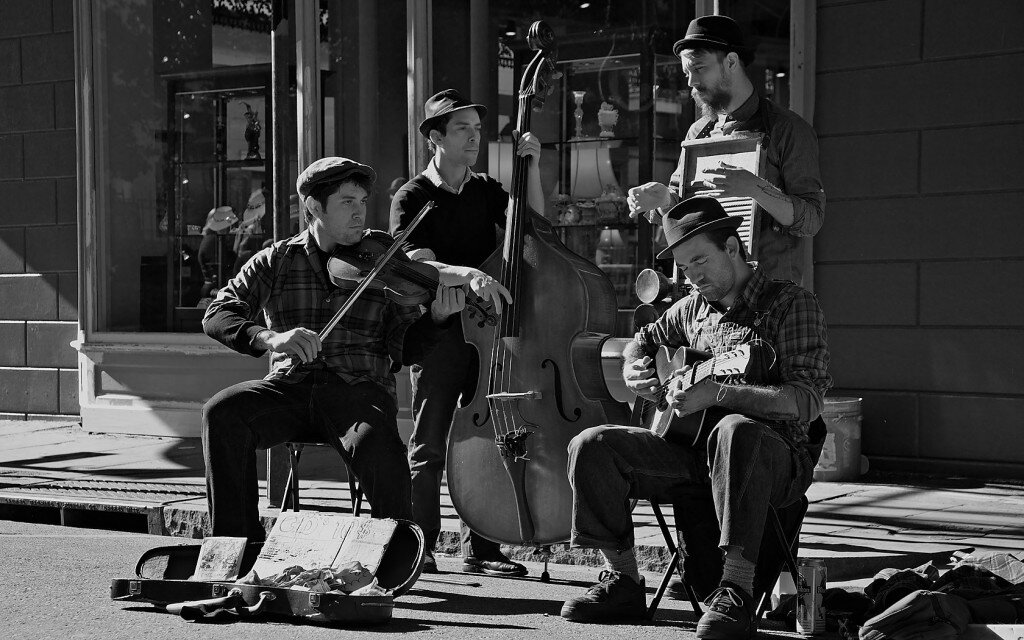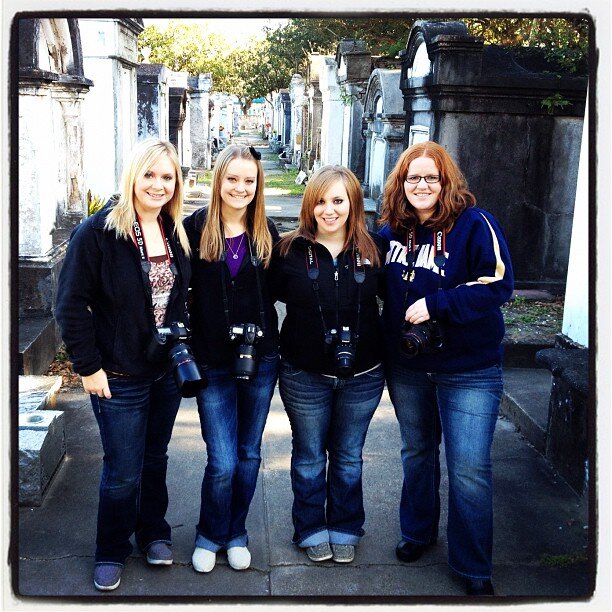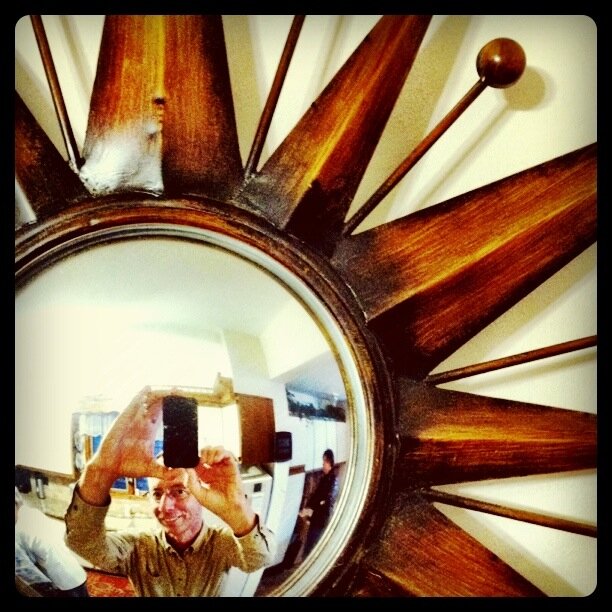people
Who Dat?
Congratulations!
 Last night the city of Watertown, the Watertown Chamber of Commerce and Focus Watertown hosted a celebration for Lake Area Technical Institute (LATI).As you may know, LATI was recently named one of the top five two-year colleges in the United States by the Aspen Insitute.Pictured here is Gary Williams, mayor of Watertown and former Director of LATI.Click here for more photos.
Last night the city of Watertown, the Watertown Chamber of Commerce and Focus Watertown hosted a celebration for Lake Area Technical Institute (LATI).As you may know, LATI was recently named one of the top five two-year colleges in the United States by the Aspen Insitute.Pictured here is Gary Williams, mayor of Watertown and former Director of LATI.Click here for more photos.
Humane Society?
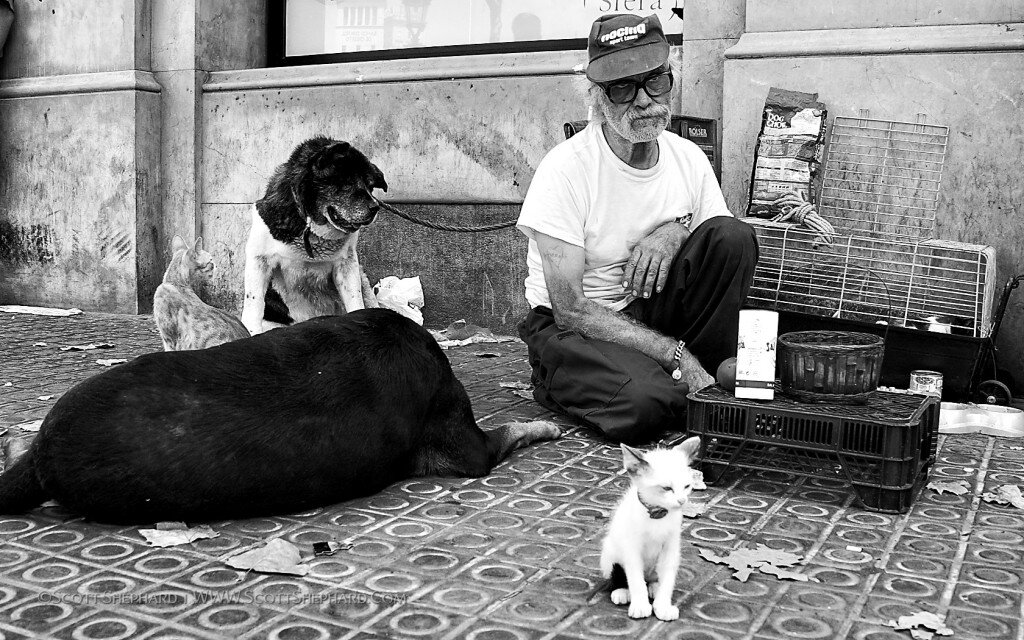 Compositionally, this isn't a very good photo. But journalistically it gets by because it does tell a story, even if you didn't know that is was taken along the Las Ramblas in Barcelona, Spain. It is a photo of a mendicant (more rudely, a beggar) and his best friends.I suspect that some may ask if he would have to beg if he weren't trying to feed 4 pets. I would ask instead, "What do you value and how much is it worth to you?"
Compositionally, this isn't a very good photo. But journalistically it gets by because it does tell a story, even if you didn't know that is was taken along the Las Ramblas in Barcelona, Spain. It is a photo of a mendicant (more rudely, a beggar) and his best friends.I suspect that some may ask if he would have to beg if he weren't trying to feed 4 pets. I would ask instead, "What do you value and how much is it worth to you?"
11-19-11 Melissa
 Melissa looks a little sad here but she was one of the more ebullient subjects I had the pleasure to photograph. She was a dancer and actively involved in theater and made posing very simple. And she had many great looks.Here, we are in an abandoned building in Gary, SD, in 2002. I had found a broken window that faced north and told her to pose by the edge. I got beautiful wrap-around Rembrandt lighting.Incidentally, one rule of thumb in portraiture is that you should avoid having the subject show the back of his/her hand to the camera and I break that rule here. Frankly, I didn't know the rule 10 years ago. I did use the "Burn" tool in Photoshop to make the hand a darker shade than the face. Why is there a rule about this? Well, partly because the back of the hand is fairly nondescript and also because any other bright object in a portrait competes with the face. And generally, portrait photographers don't want that.
Melissa looks a little sad here but she was one of the more ebullient subjects I had the pleasure to photograph. She was a dancer and actively involved in theater and made posing very simple. And she had many great looks.Here, we are in an abandoned building in Gary, SD, in 2002. I had found a broken window that faced north and told her to pose by the edge. I got beautiful wrap-around Rembrandt lighting.Incidentally, one rule of thumb in portraiture is that you should avoid having the subject show the back of his/her hand to the camera and I break that rule here. Frankly, I didn't know the rule 10 years ago. I did use the "Burn" tool in Photoshop to make the hand a darker shade than the face. Why is there a rule about this? Well, partly because the back of the hand is fairly nondescript and also because any other bright object in a portrait competes with the face. And generally, portrait photographers don't want that.
John
 This is a first in my photographic career: I tried taking photos of a child in the studio. But this is not just any child; it is John, son of Kelly, one of my second year photo students.At first I thought John was going to be a tough customer but thanks to Holly, another one of my second year students, John managed to look my way and give me a great pose. I'm not sure that this was a life-changing experience for me but would love to have another chance to take photos of John.
This is a first in my photographic career: I tried taking photos of a child in the studio. But this is not just any child; it is John, son of Kelly, one of my second year photo students.At first I thought John was going to be a tough customer but thanks to Holly, another one of my second year students, John managed to look my way and give me a great pose. I'm not sure that this was a life-changing experience for me but would love to have another chance to take photos of John.
Darcie
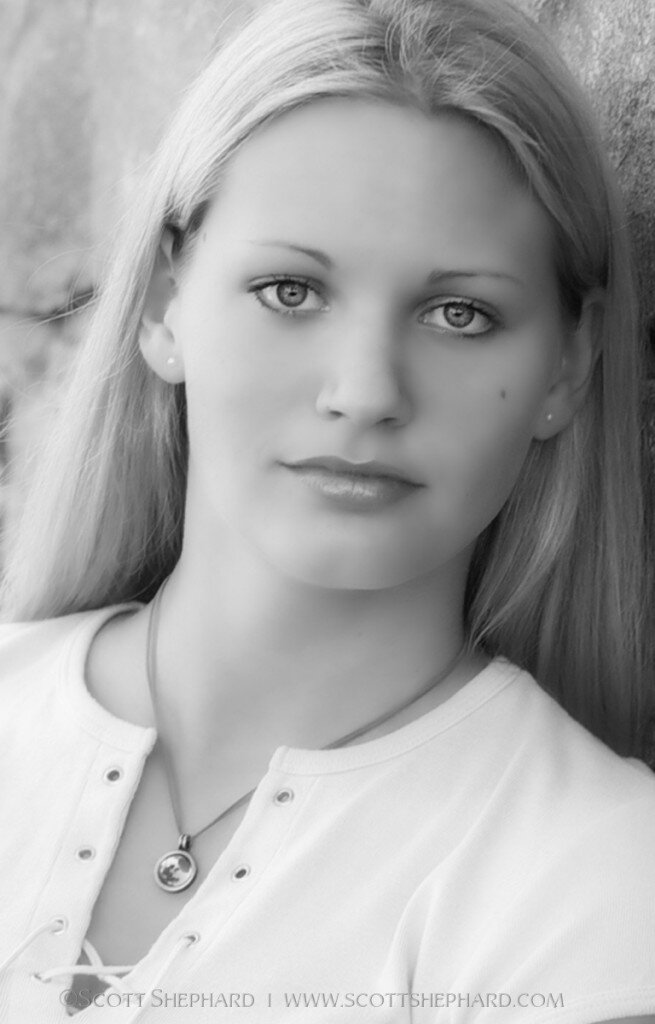 I took this portrait the first year I was serious about senior portrait photography. That was almost 10 years ago. The camera was the Canon 1D, which was a groundbreaking digital camera. It cost $5500 and had a whopping 4.4 megapixel sensor!I had a lot to learn about photographing people back in 2002 but I did get a few things right in this photo. First, how could I go wrong with Darcie? I was lucky to have the opportunity to photograph her. While I can take no credit for her good looks, I will take credit for finding the right light and the right moment for this portrait.We were at Terrace Park in Sioux Falls and I knew that the morning light was best for this particular location. That meant we had to leave Watertown pretty early to get to Sioux Falls by 9 am.As for "the moment," I will say that I had no book learning on this but that even from the beginning I had a bit of an intuitive sense of when to press the shutter button. On this particular day, I had already taken over 50 photos of Darcie and so by the time I took this one, both of us were relaxed. And anyone who does this kind of portraiture knows how important that is.(NOTE: This photo was originally posted as a color image but the more I looked at it, the less I liked it. So I have revised my post with a black and white image that does have a little "glamour" applied in Photoshop.)Canon 1D 1/125s f/4.5 ISO250 91mm
I took this portrait the first year I was serious about senior portrait photography. That was almost 10 years ago. The camera was the Canon 1D, which was a groundbreaking digital camera. It cost $5500 and had a whopping 4.4 megapixel sensor!I had a lot to learn about photographing people back in 2002 but I did get a few things right in this photo. First, how could I go wrong with Darcie? I was lucky to have the opportunity to photograph her. While I can take no credit for her good looks, I will take credit for finding the right light and the right moment for this portrait.We were at Terrace Park in Sioux Falls and I knew that the morning light was best for this particular location. That meant we had to leave Watertown pretty early to get to Sioux Falls by 9 am.As for "the moment," I will say that I had no book learning on this but that even from the beginning I had a bit of an intuitive sense of when to press the shutter button. On this particular day, I had already taken over 50 photos of Darcie and so by the time I took this one, both of us were relaxed. And anyone who does this kind of portraiture knows how important that is.(NOTE: This photo was originally posted as a color image but the more I looked at it, the less I liked it. So I have revised my post with a black and white image that does have a little "glamour" applied in Photoshop.)Canon 1D 1/125s f/4.5 ISO250 91mm
10-31-11 The Photographer's Ghost
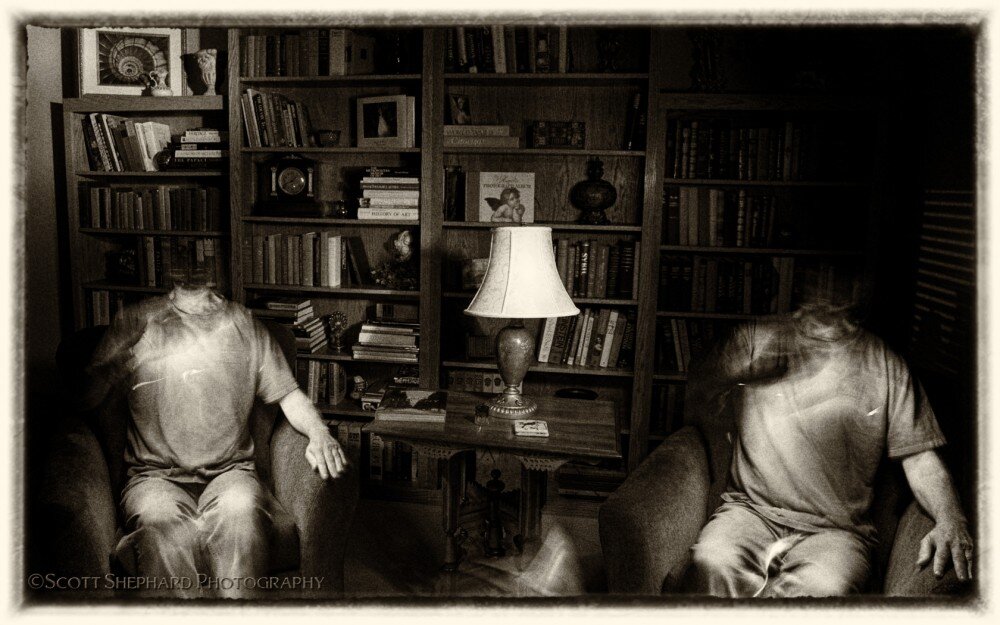 Yes, the man in the chairs is me. (I struggled hard with the grammar of this sentence.)What you are looking at is my rudimentary first attempt at light painting, which uses a long shutter speed and a flashlight of some sort. I didn't paint my head because it was very early in morning and I hadn't fixed my unruly hair yet. Plus, this photo looks better without faces on me.Happy Halloween!Canon 5DII 30s f/6.3 ISO800 24mm
Yes, the man in the chairs is me. (I struggled hard with the grammar of this sentence.)What you are looking at is my rudimentary first attempt at light painting, which uses a long shutter speed and a flashlight of some sort. I didn't paint my head because it was very early in morning and I hadn't fixed my unruly hair yet. Plus, this photo looks better without faces on me.Happy Halloween!Canon 5DII 30s f/6.3 ISO800 24mm
On Location
 Here are a few of my favorite people in one of my favorite places. The place: the old Redlin farmstead 15 miles north of Watertown. The people: Kendra, Sara, Ashley, McKenzie, Kelly, Holly and Alli (sitting). These are 6 of my second year Photo/Media students at LATI and one of my first year students (Alli). The occasion was an on-location portrait shoot.When I was doing senior portraits, I used to bring my subjects out to this old farm all the time. I liked the many looks that the buildings could give a portrait but I also liked how I could find spots with good light that were also protected from the wind. Wind is rarely an outdoor portrait artist's friend, especially with females. And in South Dakota, windy days are more common than calm ones.I had a good time on the day I took this photo but I think most of my students got better results than I did, which is what I would hope for.
Here are a few of my favorite people in one of my favorite places. The place: the old Redlin farmstead 15 miles north of Watertown. The people: Kendra, Sara, Ashley, McKenzie, Kelly, Holly and Alli (sitting). These are 6 of my second year Photo/Media students at LATI and one of my first year students (Alli). The occasion was an on-location portrait shoot.When I was doing senior portraits, I used to bring my subjects out to this old farm all the time. I liked the many looks that the buildings could give a portrait but I also liked how I could find spots with good light that were also protected from the wind. Wind is rarely an outdoor portrait artist's friend, especially with females. And in South Dakota, windy days are more common than calm ones.I had a good time on the day I took this photo but I think most of my students got better results than I did, which is what I would hope for.
Breaking Ground
 OK, so in a minor way I am breaking ground in this blog because I am A)publishing a painting and B)I am posting someone else's work. Why, you ask?The answer is that I am assigning a "Copy Da Vinci" portrait assignment to my studio photography students and I thought this might also teach you a little about how you might improve your portraits.What Da Vinci did in this painting that helped shape the future of portraiture lies in part in the way the subject is posed. Generally, portraits were full-body and in profile mode before Da Vinci. What Da Vinci did is that he angled Mona Lisa and chose to show us a view of her that focused on her face. Imagine that!Additionally, Mono Lisa is looking right at us and smiling that famous smile. The angle of her shoulders and the gentle position of her hands make Mona Lisa seem relaxed and real. Of course we try to get the same effect in modern portraits.Da Vinci did do one thing that I would tell my photography students not to do and it has to do with the way the hands are posed. These days the general rule that that the back of the hand should never face the camera. What that does is that it presents an element in the photo (due to its size and brightness) that that competes with the face. And a portrait generally is all about the face.Da Vinci gets away with this hand showing because of the neat, nearly triangular shape that defines Mona. And, of course, the face is what clearly dominates this painting.Do you want to take good photos? How about finding some great works of art and copying them. When you start to copy, you start to see techniques and compositional elements that you may not have otherwise seen.
OK, so in a minor way I am breaking ground in this blog because I am A)publishing a painting and B)I am posting someone else's work. Why, you ask?The answer is that I am assigning a "Copy Da Vinci" portrait assignment to my studio photography students and I thought this might also teach you a little about how you might improve your portraits.What Da Vinci did in this painting that helped shape the future of portraiture lies in part in the way the subject is posed. Generally, portraits were full-body and in profile mode before Da Vinci. What Da Vinci did is that he angled Mona Lisa and chose to show us a view of her that focused on her face. Imagine that!Additionally, Mono Lisa is looking right at us and smiling that famous smile. The angle of her shoulders and the gentle position of her hands make Mona Lisa seem relaxed and real. Of course we try to get the same effect in modern portraits.Da Vinci did do one thing that I would tell my photography students not to do and it has to do with the way the hands are posed. These days the general rule that that the back of the hand should never face the camera. What that does is that it presents an element in the photo (due to its size and brightness) that that competes with the face. And a portrait generally is all about the face.Da Vinci gets away with this hand showing because of the neat, nearly triangular shape that defines Mona. And, of course, the face is what clearly dominates this painting.Do you want to take good photos? How about finding some great works of art and copying them. When you start to copy, you start to see techniques and compositional elements that you may not have otherwise seen.
The Man In the Mirror
Emily
 This is a photo that I took a few years ago and used as a retouching demonstration for my Studio Photography class. It takes about 20 minutes per portrait to do the things I think need to be done, though I have Photoshop actions and filters that would do some of the same things in seconds. But while I think automation is generally good, the personal, discretionary touch of the photographer is usually better.A general retouching philosophy of mine is to avoid the temptation to "Photoshop" a photo too much. I told my students that I think that when the retouching is finished, the "real person" should remain. Skin texture, teeth color, beauty marks and scars are part of who we are. This photo of Emily is a fairly low resolution copy, but I think the an 8x10 print of this picture would reveal the "real" Emily.Canon 5dII 1/640s f/3.5 ISO400 135mm Canon 70-200 2.8 Lens
This is a photo that I took a few years ago and used as a retouching demonstration for my Studio Photography class. It takes about 20 minutes per portrait to do the things I think need to be done, though I have Photoshop actions and filters that would do some of the same things in seconds. But while I think automation is generally good, the personal, discretionary touch of the photographer is usually better.A general retouching philosophy of mine is to avoid the temptation to "Photoshop" a photo too much. I told my students that I think that when the retouching is finished, the "real person" should remain. Skin texture, teeth color, beauty marks and scars are part of who we are. This photo of Emily is a fairly low resolution copy, but I think the an 8x10 print of this picture would reveal the "real" Emily.Canon 5dII 1/640s f/3.5 ISO400 135mm Canon 70-200 2.8 Lens

